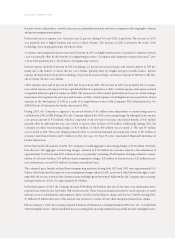American Express 2003 Annual Report Download - page 43
Download and view the complete annual report
Please find page 43 of the 2003 American Express annual report below. You can navigate through the pages in the report by either clicking on the pages listed below, or by using the keyword search tool below to find specific information within the annual report.
of their Debentures on December 1, 2006, 2008, 2013, 2018, 2023 or 2028 at 100% of the accreted principal amount, plus
accrued and unpaid interest.
This convertible debt offering has a distribution of realized financing costs that depends on the Company’s share price per-
formance. If share price remains below the conversion price, then the Company benefits from issuing inexpensive debt (at
a 1.85% coupon). However, if the share price moves above the contingent conversion price, then the debt may be converted
into common shares of the Company. This convertible debt offering was attractive due to the low effective debt coupon and
provided further diversification of the Company’s funding sources. See Note 6 to the Consolidated Financial Statements for
a more complete discussion regarding the terms of this offering.
At December 31, 2003 and 2002, the Parent Company had $1.8 billion and $2.8 billion, respectively, of debt or equity secu-
rities available for issuance under shelf registrations filed with the Securities and Exchange Commission (SEC).
The Board of Directors has authorized a Parent Company commercial paper program supported by a $1.29 billion multi-
purpose committed bank credit facility that expires incrementally through 2007. There was no Parent Company commer-
cial paper outstanding during 2003 and 2002, and no borrowings have been made under its bank credit facility. The
Company maintained total committed bank lines of credit with approximately 60 large financial institutions totaling $10.85
billion at December 31, 2003, which include the Parent Company credit lines. The availability of the credit lines is subject
to the Company’s compliance with certain financial covenants. See TRS’ Liquidity and Capital Resources discussion for
details of the principal covenants that govern this committed bank credit facility.
In addition, TRS, Centurion Bank, Credco, American Express Overseas Credit Corporation Limited (a wholly-owned sub-
sidiary of Credco) and AEB have established programs for the issuance, outside the United States, of debt instruments to be
listed on the Luxembourg Stock Exchange. The maximum aggregate principal amount of debt instruments outstanding at
any one time under the program will not exceed $6.0 billion. At both December 31, 2003 and 2002, $0.5 billion of debt
was outstanding under this program.
Off-Balance Sheet Arrangements and Contractual Obligations
The Company has identified off-balance sheet transactions, arrangements, obligations and other relationships that may have
a material current or future effect on its financial condition, changes in financial condition, results of operations or liquid-
ity and capital resources.
Contractual Obligations
The contractual obligations identified in the table below include both on- and off-balance sheet transactions that represent
material expected or contractually committed future obligations of the Company:
Payments due by year
2009 and
(Millions) Total 2004 2005–2006 2007–2008 thereafter
On-Balance Sheet:
Long-term debt $20,654 $ 3,452 $ 12,136 $ 1,747 $ 3,319
Lease obligations 53 5 19 1118
Other long-term liabilities(1) 3,802 1,514 904 632 752
Off-Balance Sheet:
Lease obligations 2,487 273 446 328 1,440
Purchase obligations(2) 9,308 2,284 2,578 2,067 2,379
Total $36,304 $ 7,528 $ 16,083 $ 4,785 $ 7,908
(1) Other long-term liabilities exclude insurance and annuity potential payments that are primarily not time certain and are represented by reserves of approximately $32 billion at December 31, 2003.
(2) Purchase obligations include agreements to purchase goods and services that are enforceable and legally binding on the Company and that specify significant terms, including: fixed or
minimum quantities to be purchased; fixed, minimum or variable price provisions; and the approximate timing of the transaction. The purchase obligation amounts include expected
spend by period under contracts that were in effect at December 31, 2003. Minimum contractual payments associated with purchase obligations, including termination payments, were
$340 million.
(p.41_axp_ financial review)
























